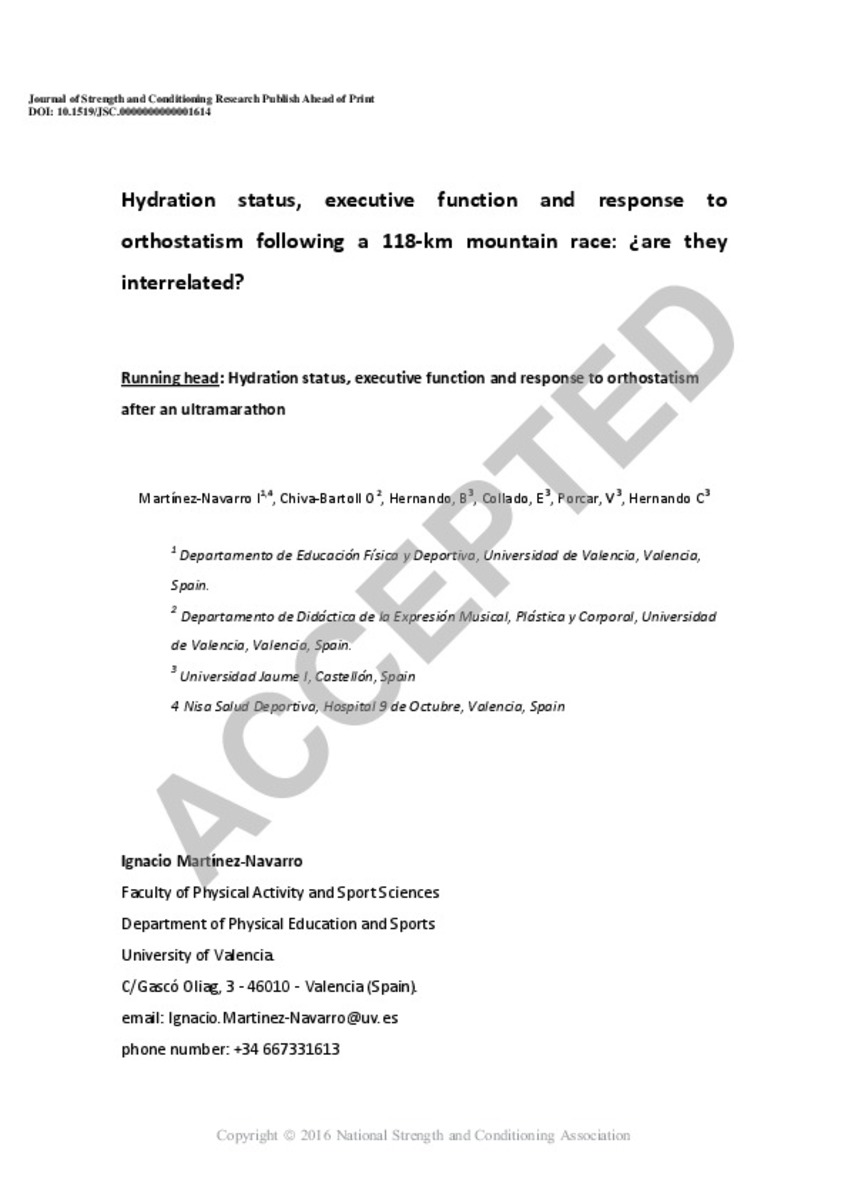Mostrar el registro sencillo del ítem
Hydration status, executive function and response to orthostatism following a 118-km race: are they interrelated?
| dc.contributor.author | Martínez Navarro, I . | |
| dc.contributor.author | Chiva-Bartoll, Oscar | |
| dc.contributor.author | Hernando, Barbara | |
| dc.contributor.author | Collado-Boira, Eladio | |
| dc.contributor.author | Porcar Blanch, Vicente | |
| dc.contributor.author | Hernando, Carlos | |
| dc.date.accessioned | 2018-06-12T12:23:43Z | |
| dc.date.available | 2018-06-12T12:23:43Z | |
| dc.date.issued | 2018-02 | |
| dc.identifier.citation | MARTÍNEZ-NAVARRO, Ignacio, et al. Hydration Status, Executive Function, and Response to Orthostatism After a 118-km Mountain Race: Are They Interrelated?. The Journal of Strength & Conditioning Research, 2018, 32.2: 441-449. | ca_CA |
| dc.identifier.uri | http://hdl.handle.net/10234/175120 | |
| dc.description.abstract | The present study aimed to explore whether blood pressure (BP) and heart rate (HR) variability (HRV) responsiveness to orthostatism, jointly with executive function (EF) performance, was diminished after an ultra-endurance mountain race. Besides, we wanted to assess whether hydration status was related to either performance or the abovementioned alterations. Fifty recreational ultra-endurance athletes participating in the Penyagolosa Trails CSP115 race (118 km and a total positive elevation of 5,439 m) were evaluated before and after the competition. The HRV and BP were measured in response to an orthostatic challenge. The EF was evaluated using the color-word interference task of the Stroop test. Body mass (BM) and urine specific gravity (USG) changes were used to assess hydration status. The HRV and BP responsiveness to orthostatism was diminished after the race. Besides, a significant BM loss of 3.51 ± 2.03% was recorded. Conversely, EF and USG showed no significant changes from prerace to postrace. Eventually, BM loss was inversely related to finishing time (r = −0.34) and postrace orthostatic HR and EF were positively associated (r = 0.60). The USG and BM loss appear to provide different insights into hydration status, and our results challenge the well-established criteria that BM losses >2% are detrimental to performance. Coaches are advised to consider athletes' performance level when interpreting their BM changes during an ultra-endurance competition. Similarly, coaches should be aware that increased vulnerability to orthostatism is a common phenomenon after ultra-endurance races, and diminished HR responsiveness to orthostatism could constitute a practical indicator of EF worsening. | ca_CA |
| dc.format.extent | 32 p. | ca_CA |
| dc.format.mimetype | application/pdf | ca_CA |
| dc.language.iso | eng | ca_CA |
| dc.publisher | National Strength and Conditioning Association | ca_CA |
| dc.rights | Copyright © 2018 by the National Strength & Conditioning Association. | ca_CA |
| dc.rights.uri | http://rightsstatements.org/vocab/InC/1.0/ | * |
| dc.subject | ultraendurance | ca_CA |
| dc.subject | heart rate variability | ca_CA |
| dc.subject | Stroop test | ca_CA |
| dc.subject | urine specific gravity | ca_CA |
| dc.subject | performance | ca_CA |
| dc.title | Hydration status, executive function and response to orthostatism following a 118-km race: are they interrelated? | ca_CA |
| dc.type | info:eu-repo/semantics/article | ca_CA |
| dc.identifier.doi | https://doi.org/10.1519/JSC.0000000000001614 | |
| dc.rights.accessRights | info:eu-repo/semantics/openAccess | ca_CA |
| dc.relation.publisherVersion | https://journals.lww.com/nsca-jscr/Abstract/2018/02000/Hydration_Status,_Executive_Function,_and_Response.17.aspx | ca_CA |
| dc.contributor.funder | NISA Hospitals group, HG Sports, Oximesa S.L. and "Cátedra Endavant Villarreal CF de l'Esport" | ca_CA |
| dc.type.version | info:eu-repo/semantics/updatedVersion | ca_CA |
Ficheros en el ítem
Este ítem aparece en la(s) siguiente(s) colección(ones)
-
EDU_Altres [8]







